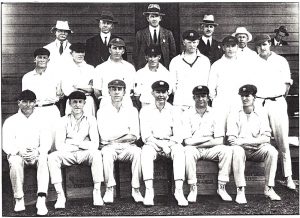Formation of the Club
The origins of the Northern Suburbs Cricket Club date back to 1903. In that year the local Association, then known as the Hunter River District Cricket Association, decided to introduce a District system of cricket in place of the Club system that had previously operated since the foundation of the Association in 1894.
This was done in an attempt to revive the flagging local competition that had declined to the stage where there were only three teams left in the senior competition. It was also hoped that the new system would help to even out the competition that had previously been dominated by the Albion and Pearl Clubs.
Under the new District format, Maitland was divided into three cricket Divisions – Northern, Southern, and Western.
The Northern Division was defined as comprising the area bounded by the northern side of High Street from High Street station to the Rutherford Hotel, including Oakhampton, Lorn, and Horseshoe Bend.
Two general meetings marked the final stages in the formation of a new Club in the Northern Division area. The first was held at the Belmore Hotel on August 31, 1903.
This meeting considered a code of rules for the management of the Club, that had previously been drawn up by a sub-committee, and appointed John Kerrigan and Frank Drew as delegates to the Association’s Annual General Meeting. A report of this meeting appeared in the Maitland Mercury the following day:
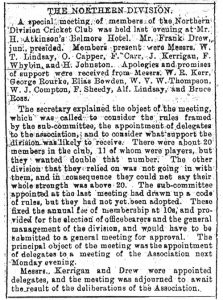
At the second general meeting held on September 30, 1903, at Frank Drew’s residence in Lorn the Northern Division Club was formally constituted, the rules (25 in number) were submitted and adopted with some minor alterations and the office-bearers and committee for the new Club were appointed. John Rourke Sen. was elected as the first President; John Kerrigan as Secretary; and Harold Johnston as Treasurer.
The First Season
Following the formation of the Club, two teams were entered in the competitions of the Hunter River District Cricket Association for the start of the 1903-04 season – an A team in the Senior competition (First Grade) and a B team in the Junior Badge competition (Reserve or Second Grade).
Other teams in the senior competition included Southern Division, Western Division, East Maitland, Morpeth, Hinton, Lochinvar, and Paterson.
It was appropriate that Northern Division’s first official competition match in the senior grade was against East Maitland – a Club that was to become arch-rival over the following years. This was a two-day fixture played at the Albion ground on October 10th and 17th, 1903.
Northern scored 186 and then dismissed East Maitland for 91 to gain a win by 95 runs on the first innings. Following is the report of the first day’s play from the Maitland Mercury:
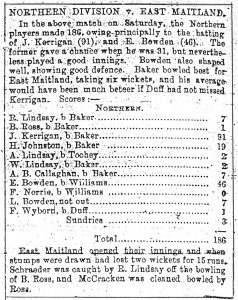
Looking at the score-sheet for the match, one finds that the Northern batting line-up included a number of players from the former Albion Club which disbanded shortly after the introduction of District cricket. These included Robert Lindsay. John Kerrigan, Harold Johnston, William Lindsay, Alf Lindsay, Felton Norrie, and Elias Bowden. No doubt these players would have brought across to their new Club some of the traditions and character associated with the Albion Club, particularly when Northern Division’s “home matches” until after World War 1 were played on the old Albion ground.
The Albion Club (founded in 1866) was a well-known club in the early history of Maitland cricket. Its high-quality ground and turf wicket, situated on the present site of Maitland Showground, was widely regarded as “being unsurpassed in the colony outside of Sydney” and had been the venue for matches against a number of visiting International Teams. The club was run along the lines of an English county club and members enjoyed facilities such as practice ground staff bowlers and private lockers that would be the envy of many club cricketers today.
In its first season the Northern Division A grade team, under the captaincy of William Lindsay, recorded four wins, two losses, and two draws to finish third to both Western Division and Lochinvar that tied for the premiership. The B grade team finished fourth in its competition.
The first century-maker for the Club was Felton Norrie who scored 104 in a match against Paterson on the Albion ground. Seven members of the Club also represented the Association in district matches.
During the first season Club membership totaled 35, of whom 27 were players. John Rourke, the President, was interstate for most of the season and in his absence, the role of acting President was taken on by the Vice-President, Elias Bowden. At the first Annual Meeting in August 1904, Bowden congratulated the members “on the harmonious manner” in which the Club members had worked together “in fulfilling their engagements in a sportsmanlike way, extending the hand of friendship with whom concerned, whether winning or losing”.
Early Premiership Success
Northern Division Club had its first premiership success when it won the Junior Badge competition in the 1905-06 season.
After finishing runner-up in four out of its first five seasons in the senior competition, Northern eventually won the Johnston Cup for the senior premiership in the 1908-09 season when it won four out of its five matches. However, the victory was a rather hollow one as by that stage the senior competition had again declined to the point where it was described by an Association official as “practically a farce, with only two Clubs remaining in it”.
By 1911 Northern Division was the only District Club that had survived and as a result, the 1911-12 season saw a return to Club cricket which had operated prior to 1903.
In the period leading up to 1915 when local competition cricket was suspended because of World War 1, Northern Division won two further Senior first grade premierships – in 1912-13 and 1914-15.
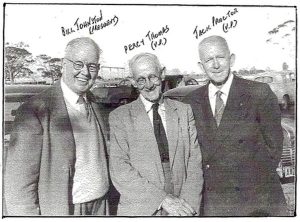
An Early Norths Legend – Bob Lindsay Snr
A prominent cricketer in the early history of Northern Division Club was Robert (“Bob”) Lorne Lindsay. Bob Lindsay, as he was familiarly known, was born in Tamworth in 1873 and prior to becoming a member of Northern Division Club, began his cricketing career as a young schoolboy with the Albion Club. There he soon established a reputation as a fine left-hand opening batsman and as a cricketer with real potential. Frank Iredale, an Australian Test player, who saw him in action during the 1890s, gave him high praise, describing him as “a fine batsman” who has “every promise of developing into a really good cricketer … he has all the essentials of a good batsman, and has, moreover, what is a strong characteristic in him, absolute fearlessness”.
In the 1901-02 season when playing for the Albion Club against East Maitland on the Albion ground, he figured in a first wicket partnership of 444 with Charlie Onus. Lindsay scored 242 n.o. and Onus 192.
The Mercury reported that “Lindsay played with great judgment and gave no chances”. At the time the partnership was claimed as an Australian record and not surprisingly it has remained as a long-standing district record.
Before coming to Northern Division, Bob was a regular member of the Northern District representative teams. He played against Stoddart’s English X1 in 1894-95 and 1897-98 and against Archie McLaren’s English X1 in 1901. In the match against McLaren’s X1 at the Albion ground, he had the distinction of becoming the first Hunter Valley batsman to score a century against an English touring team when he showed “great maturity and much variety in his stroke-making” to score 104 in the Northern District 18’s mammoth total of 15 for 558. In recognition of his effort, he was presented with a gold medallion by “his admirers”.
In 1900-01 Bob played in the Sydney competition with Central Cumberland and topped that Club’s batting average with 55. However, the following season he returned to play with Albion.
After coming to Northern Division in 1903, Bob continued to show outstanding form and to set new records. His best season was in 1904-05 when his aggregate was 842 runs including four centuries, establishing a district record for the highest aggregate and most centuries in a season – a record that has not been bettered to this day!
In the 1908-09 season, he scored another double century when he hit up 226 against Western Division on the Albion ground. His innings included 28 fours and 3 sixes and was described as “a brilliant exhibition of all-round cricket”. This second double century made him the only player in the history of the Association to score two double centuries – another record that has remained unbroken!
Bob was President of the Club from 1919-28 and continued to play first grade up until 1928 when a bitter dispute with the Association over the suspension of a player led to his retirement as a player and to his resignation as Club President. During his time with Northern Division, he was a prolific run-getter and frequently headed the District and Club batting averages. By the end of the 1924-25 season, he had topped the Club’s batting average in 14 out of 18 seasons. It was also calculated that by that time he had played 154 innings for the Club, had been not out 34 times, and scored 6214 runs at an average of 51.7. Even at the age of 49 he still headed the Club and District batting aggregate in the 1921-22 season with 423 runs at an average of 60.7. ln addition to his batting prowess, he was also a useful left-hand spin bowler and frequently figured near or at the top of the Club’s bowling averages for the season.
While with Northern Division, Bob continued to achieve representative honors. He played for a Northern District 18 against “Plum” Warner’s MCC team in 1903 and for a Northern District 15 against the touring South African team in 1910. He is also reported to have toured NZ with an NSW team but the date for this is unknown.
In his professional life, Bob was an auctioneer – a popular and well-known figure at the stock sale yards at Campbells Hill. For the greater part of his life, he was associated with the firm of E.W.Sparke until he formed a company known as R. & L. Lindsay in partnership with his son Robert Lindsay Junior.
Both of his sons, Robert Jnr and Jim, later played with Norths. Unfortunately, Robert Junior died in World War 2 on the infamous Sandakan “death march” in Borneo.
When Bob Lindsay Senior died in 1935 at the age of 62, the legendary proportions that he had achieved with Northern Division, were revealed by the remark of one of his fellow players, when referring to Lorn Oval which was his home ground in the latter stages of his career: “That was his Park. We called it ‘Lindsay Oval’.”
The Start of the Johnston Tradition
The name of Johnston and Norths Cricket Club are almost synonymous. Four generations of the family have been closely associated with the Club over the past century.
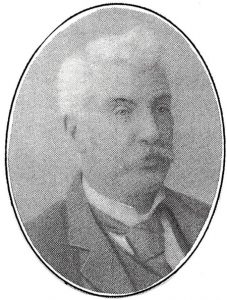
Alfred Johnston, the founder of Johnston’s Boot Store in Maitland in 1885, was a keen follower of cricket. He was Vice-President of the Club for 22 years and during that time was a generous benefactor and supporter.
Two of his sons, Harold and Will, were to become prominent identities with the Club during its early years.
Harold Johnston was a foundation member of the Club. Prior to coming to Northern Division, he had previously played with the Albion and Pearl Clubs. He was to become well known for his prowess as an opening batsman.
Though not in the same class as Bob Lindsay, Harold’s performances for Northern Division were very impressive.
By 1914-15 he had completed his hundredth innings for the Club averaging 27 per innings. Two of his best seasons were in 1911-12 when he scored 395 runs at an average of 43.8 and in 1914-15 when he scored 372 runs at an average of 28.6.
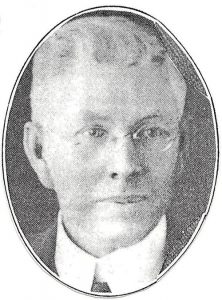
He still continued to play on after the war and in 1920-21 was fifth in the district averages with 341 runs at an average of 34.1.
He was very active in the administration of the Club, serving as the foundation Treasurer and as Secretary for fourteen years from 1905-15 and from 1922-26. For six seasons prior to World War 1, he combined the roles of Secretary and Treasurer. Frequent Annual Meetings paid tribute to the work that he did for the Club. For instance, at the 1913-14 Annual Meeting, Elias Bowden, the President, complimented the Secretary “on the way he had carried out his duties, and thought the position of the Club was in large measure due to him”. He was also Treasurer (1919-24) and Life Member of the Association and was the second President of the Hunter Valley Cricket Council from 1927-35.
Even after retiring from playing cricket with Northern Division in the early 1930’s, he still continued to take an active interest in the affairs of the Club and was a Vice-President at the time of his death in 1956.
His son, Basil, was to carry on the family tradition.
Will Johnston joined his brother, Harold, in 1903 in the first season of the Club. He was to remain a member or office-bearer with the Club for the next sixty-five years.
He was described as “not a superlative bowler” but one who “always gets wickets” and as “a handy change man”. He was also a useful batsman and in 1921 at Lorn Park scored 114 not out in a first-grade match against Brunkerville, sharing in a ninth wicket unbeaten partnership of 192 with Colin Collard to create a district record that still stands to this day.
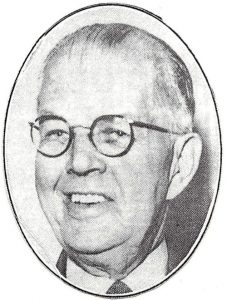
As a fieldsman, he earned the reputation of having “a very safe pair of hands” and it is reputed that in all his playing days with Norths from 1903-27 he only dropped one catch!
Highly respected as a leader and captain, for many years he skippered the District John Bull Shield and Northern District representative teams. One of the proudest days of his life was when he led the Northern District team onto the field at the Maitland Showground in 1925 against Arthur Gilligan’s M.C.C. team. This was a match that Will was largely responsible for gaining for Maitland and one that brought a handsome profit to the local Association.
However, he always seemed proudest of his part in the construction of the turf wicket, oval fence, and pavilion at Lorn Park in the early 1920’s. These new features were opened by Will Johnston’s side against a team of interstate and international players brought to Maitland by his school and life-long friend, the famous Australian Test batsman, Charlie Macartney.
Will was President of the Club from 1936-41 and from 1946-47 and then Vice- President and Patron. ln his later years after his retirement from playing in 1927, he was a keen spectator each Saturday at Club matches. Having served as Association Vice- President from 1920-28, he was made a Life Member of that organisation in 1950 for his services to Maitland cricket.
Above all, Will was one of those members largely responsible for setting the highest standards for young cricketers. As the 1967-68 Annual Club report recorded in his obituary notice: “Nothing gave him more satisfaction than to see a young player, not only those from our club succeeding. His criteria were keenness in the field, energy when batting or bowling, and proper cricket attire. If these requirements were fulfilled you had prospects on and off the field; if you did not, if sloppiness was evident, then, he believed, you should not be playing cricket.”
These were part of the tradition that was to be carried on by his two sons – Colin and Alan – into the next generation.
Painting the Picket Fence
One of Col Johnston’s earliest memories of Lorn Park was about painting the picket fence. Recalling the experience, he wrote “In 1923 Macartney paid another visit to Lorn Park – this time to christen the new picket fence. I remember that better because my grandfather (Alfred), an original Vice President of Norths when formed in 1903, had retired. I was his assistant at painting the new fence.”
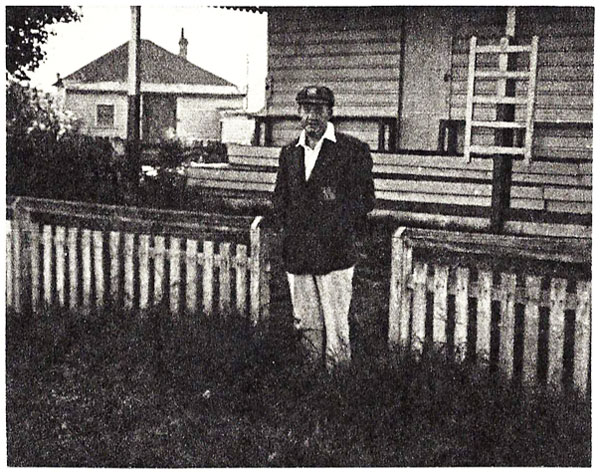
Resumption After The War
After a lapse of four seasons (1915-19) on account of the First World War the local competition was resumed in 1919. A meeting to re-form Northern Division Club was called for September 16, 1919. Apparently, the time-lapse had caused some confusion for the notice advertising the meeting referred to the “12th Annual Meeting” when it was actually the 13th.
At the meeting, the “carry-over” Secretary, Harold Johnston, expressed the hope that during the approaching season the Club would be able “to place the good old game in its former position” and appealed to Club members “to do their best to place Northern Division in the same high sphere that it occupied previous to going into recess”. Mr.J.J. Mitchell was also congratulated on his safe return from active service.
The Club’s executive was re-formed with Bob Lindsay Senior elected as President and Cyril Collard as Secretary and Treasurer. Two teams (an A and a B grade) were entered in the Association’s competitions.
Under the captaincy of Bob Lindsay Senior, the A grade team’s first match was played against Kurri Kurri at Lorn on October 11 &18. Included in the Northern Division batting line-up, though lower down the order than in the pre-war days, were the names of R.Lindsay, H.Johnston, and W.Johnston – all foundation members of the Club.
Early Ground Improvements
Prior to 1915 a matter of concern constantly expressed at Annual Meetings was the lack of a home ground for the A grade team to play upon and practice. For instance at the 1905-06 Annual Meeting John Kerrigan commented that “if the club had a ground at its disposal, it would advance by leaps and bounds”.
There was a concrete pitch at Lorn Park but prior to 1915, this was only used for home matches for the B grade team.
In the early 1920’s substantial improvements were carried out at Lorn Park that was to transform the situation. A lot of the credit for these changes must go to Bob Lindsay Senior who was Club President at the time of the major improvements. As Will Johnston stated in 1935, when paying tribute to the Club’s former President: “The Lorn Oval was practically reclaimed from a bush ‘paddock and developed under the guiding influence of Mr.Lindsay, to its present state, which was a credit to all concerned.”
By September 1921 a wooden pavilion had been erected on Lorn Park using the voluntary labor of Club members and timber supplied by the Bolwarra Shire Council. Mr. T.W.Silk supplied the plans and specifications for the pavilion and Mr.Abe Pilgrim supervised its construction. In recognition of his assistance, the Club made Abe Pilgrim a Life Member.
In 1921 the Club obtained permission from the Shire Council to put down a turf wicket. This work was completed by the end of the 1921-22 season.
During the 1922-23 season a picket fence was erected around the oval. This was done with voluntary labor and with the support of the Bolwarra Shire Council which again assisted by subsidising the cost of the material on a pound for pound basis with an amount of thirty eight pounds ten shillings.
The 1922-23 Annual Report recorded that “during the past two years improvements to the oval conservatively estimated at 300 pounds had been made”. The following season’s Report noted that the “innovation of charging wicket fees” had been a great success and that as a result, the Club had been in a financial position to appoint Mr.D.Ross as the caretaker of the Oval.
With all these changes the Maitland Mercury commented: “The Northerners have said that they are going to make theirs the best oval in the district and the great amount of voluntary work put in there by them shows that it is no idle boast.”
Charlie Macartney
Charlie Macartney is possibly the closest Maitland can come to claiming an Australian Test player. He was born in Maitland on June 27, 1886, and spent his childhood in the district before moving to Sydney in 1898.
The story goes that he traced his cricket prowess to his grandfather (George Moore) who bowled apples at him from the orchard and shaped his first cedar bat.
Charlie went on to become one of “the greats” of Australian Test cricket and is often ranked behind Bradman and Trumper as the third-best ever Australian batsman.
Outside Australia, he played in South Africa, New Zealand, England, America, and India. Against England, he made 1640 runs at 43.15 including 5 centuries. In all first-class games, he scored 17,217 runs at an average of 47 and made 48 centuries.
On his fourth trip to England at the age of 41, he made a century before lunch in a Test match at Headingley. So confident was he in his batting, he was called “The Governor General”.
In his book “My Cricketing Days” he relates an interesting anecdote about his early days in Maitland: “Cricket came before everything, and I and my other ambitious companions were always out for worlds to conquer. And this reminds me of one afternoon at Lorn, West Maitland – I was about nine or ten at the time – when I was in the running with another ‘big boy’ (Bill Johnston who has for many years been one of the bulwarks of sport in the Hunter River district, and my very good friend) for last place in the local eleven. The mate was between Lorn and Hinton played on the local paddock. Great was my disappointment when Bill was selected and I sat under the pepper tree all the afternoon, watching and wishing I had been in the side.”
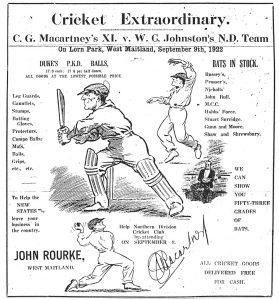
The Macartney Matches
To mark the official opening of improvements to Lorn Park two special matches were arranged against teams led by Charlie Macartney, the great Australian Test batsman – one in 1922 and the other in 1923.
The 1922 Match – This match was arranged mainly through the influence of Will C.Johnston who was a friend of Charlie Macartney’s from former schooldays spent together at Maitland Primary School.
Will persuaded Charlie to bring to Maitland a team that included a number of international and interstate players – Alan Kippax, Bert Oldfield, Johnnie Taylor, Tommy Andrews, “Johnnie” Moyes, and Bill Trenerry (a former local player) – to play a match at Lorn Park on September 9, 1922, to mark the official opening of the new turf wicket. Dr.Neil Blue, who had brought University teams to Maitland in the pre-war days, accompanied Macartney’s team as Manager.
The local Northern District XIII was captained by Will Johnston and included two other Northern Division players – Les Manners and Roy Oakes – with Rev.H.R. Holmes named as the reserve. Other local players in the team were L.Moore, R.McLean, H.Patfield Snr. (Robins) and J.McEnearney (Marist Brothers). While invited players from outside the Hunter River Association’s District were Dr.E.P.Barbour, S.McGlynn (Newcastle), B.Watson (Taree), W.Jarrett (Eccleston), R.Fawcett and C.Morrissey (Singleton).
Elias Bowden, Patron of the Northern Division Club, had the honour of declaring the wicket officially open and bowling the first ball to Charlie Macartney.
The Northern team batted first and closed their innings at 7 for 185 with Dr.Eric Barbour top-scoring with 94. In reply, Macartney’s team was dismissed for 215 with “Johnnie” Moyes and Johnny Taylor both scoring fifties with some hard-hitting. The best of the local bowlers was R.McLean who took 5 for 44.
The weather on the Saturday morning of the match was threatening but by mid-afternoon when the weather had cleared, the crowd at the match was estimated to have grown to 2500. The net profit, mainly gained from gate takings for the match, was eighty seven pounds and this was later spent on further improvements to the ground.
During their stay in Maitland, Macartney and his team were “royally” entertained. On the morning of the match, they were given a civic welcome by the Mayor at the Town Hall. The match luncheon was provided “in splendid style” by a committee of ladies who had adorned the tables “in a beautiful decorative scheme” with the green and gold colours of the Australian Eleven. On the Saturday night a complimentary dance was arranged for the visitors in the School of Arts and on the Sunday they were taken for a motor tour drive around the local district to Paterson, Hinton, and Morpeth.
Shortly after his return to Sydney, Macartney wrote a letter to Will Johnston thanking him and all concerned on behalf of the team for “the most magnificent weekend” and lavish hospitality that they had received on their visit to Maitland. He went on to express his delight at his “homecoming” to Maitland: “Personally I can only look upon the whole thing as an honour done to me by my native town, and I want you to thoroughly realise how much I do appreciate it, and what a real pleasure it was to visit West Maitland again.”
In addition, he hoped that the match might become an “Annual Social arrangement” and concluded with some complimentary remarks about Lorn Park:” … your ground and wicket at Lorn Park are a credit to you, and no first-class groundsman could have prepared a better wicket than the one introduced to me last Saturday morning. lt speaks volumes for your voluntary workers and helpers, and many country districts could take pattern by you. I consider that in two, or perhaps three years, you will have a ground fit to compare with the best Club ground in the State.”
At a later meeting of Northern Division Club Will Johnston was presented with two enlarged framed photographs – one of Macartney’s team and the other of his own team – as a tribute to his organising ability in making such successful arrangements for the match.
The Club’s Annual Report for the 1922-23 season stated that “the visit of C.G.Macartney’s international eleven was a great success – socially and financially, and was instrumental in causing an increased interest in cricket generally during the season”.
Will Johnston 1922 Team
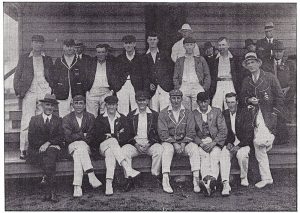
The 1923 Match
Following the success of the first match, a return visit of Macartney’s team was arranged for the beginning of the 1923-24 season. This time the special occasion was to mark the erection of the new picket fence around the oval.
Testimony to the hospitality that they had received from the locals on their first visit was that every member of the previous season’s team accepted the invitation to come back again.
An addition to the team was another international Jack Gregory, a fine all-rounder, who had played with the AIF team at the end of World War 1 and had been very successful against England in the 1920-21 series in Australia and on tour in 1921.
The local team was again captained by Will Johnston and included thirteen players. Among these from the previous match were R.Oakes (Northern Division), E.P.Barbour and S McGlynn (Newcastle), C.Morrissey (Singleton), R.McLean and H.Patfield Snr. (Robins). New members of the team were J.C.Long (Northern Division), C.A.Sivyer (Allynbrook), C.Bendeich and D.E.Thrift (Branxton), G.Bell (Morpeth), and V.Cleary (Marist Brothers).
The match was played on September 8, 192. While the weather was fine on the day of the match, heavy rain on the Friday afternoon had softened the wicket when water leaked through the tarpaulins covering the pitch. However, to get the match underway, a mat was spread over the turf and play took place on this surface.
Having lost the toss and being sent in, the locals batted on a difficult pitch and struggled to make 86. The best of the bowlers for Macartney’s team were E.W.Adams who took 5 for 37 while Gregory and Macartney each took two wickets.
In reply, Macartney’s team scored 7 for 265 with Johnny Taylor and Jack Gregory both scoring fifties. After being missed early on, Macartney scored an attractive 34 in an innings described as one “giving pleasure to the spectators”.
The attendance at the match was estimated at over 3000.
After the match, Macartney and his team were entertained along similar lines to the previous season – a dance on the Saturday night at the School of Arts followed on the Sunday by a motor tour of the local district, including a visit to John Tucker’s orchard at Paterson.
It was reported that “all expressed appreciation of the delightful time that they had” and that Macartney commented: “It is hard to say it, but I think you gave us a better time than last year”.
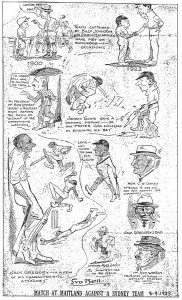
Will Johnston 1923 Team
